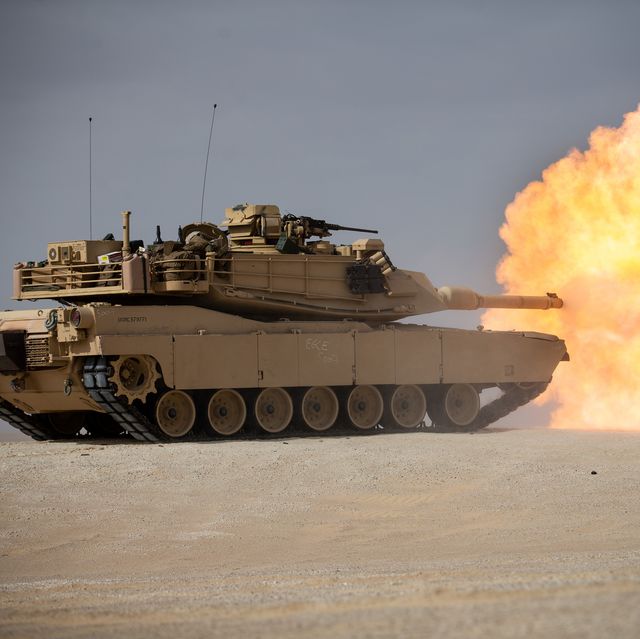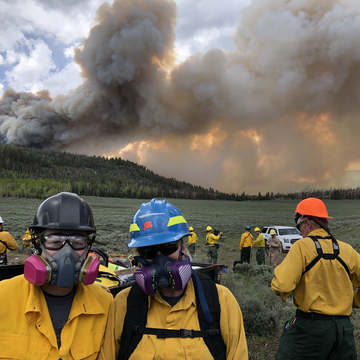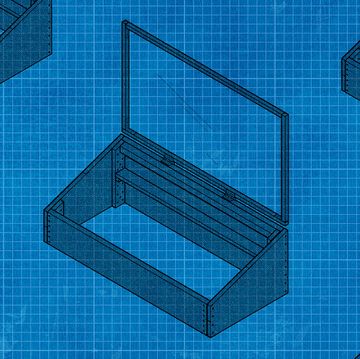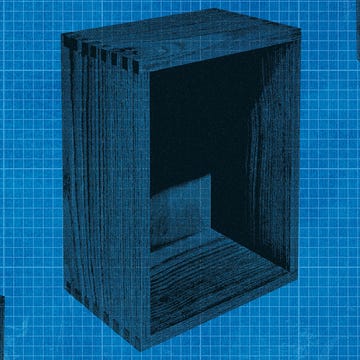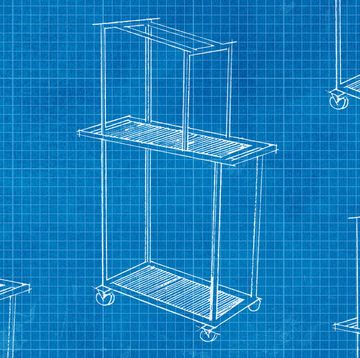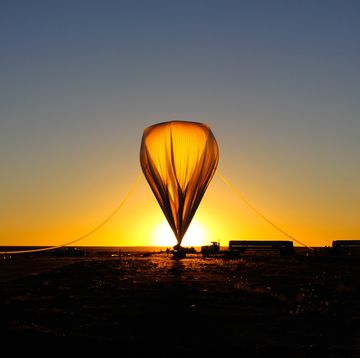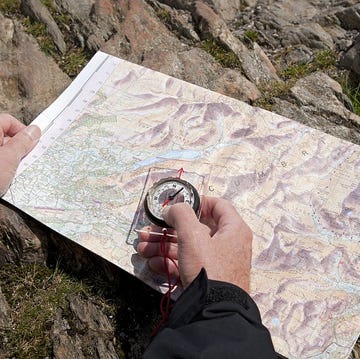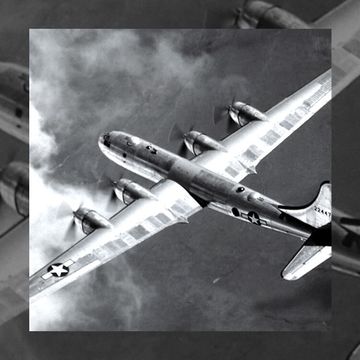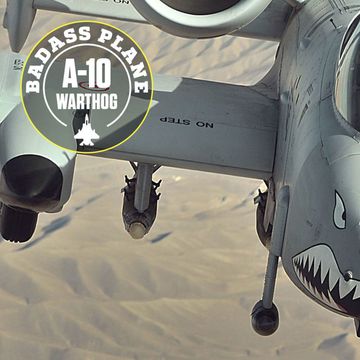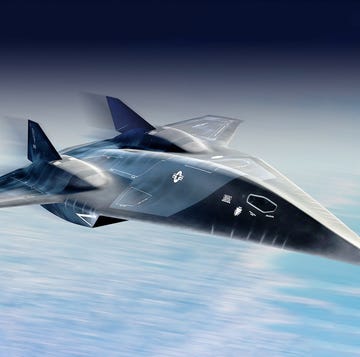“Eagle Troop, battle stations. Tanks lead, go to tanks lead,” barked Army Captain H.R. McMaster, then just 28, over the radio. Eagle Troop’s nine M1A1 Abrams battle tanks moved to the front of the unit and pressed into a V formation on the surface of the Iraqi desert. They led 12 M3A2 Bradley Fighting Vehicles and 120 soldiers. Just ahead, obscured by sandstorms and dirt embankments, lay an embedded force of the Iraqi Republican Guard’s Tawakalna Division and the Iraqi 10th Armored Division: 39 tanks, 54 armored vehicles, and more than 200 infantrymen. But the American M1A1 Abrams had been purpose-built to overpower exactly these tanks.
It was the third day of the Persian Gulf War ground invasion—February 26, 1991. Eagle Troop was pushing east through Iraq in advance of the U.S. Army’s VII Corps, headed toward 70 Easting—a checkpoint where they would wait to regroup with the 1st Infantry Division behind them. U.S.-led coalition forces had already forced the Iraqi army into a retreat, but now Iraq’s elite Republican Guard was digging in to stop the coalition’s advance. The Iraqi forces waiting for Eagle Troop just past 70 Easting had bolstered their position with armored vehicles, ground personnel, and minefields directed at the American advance. Visibility was low. Captain McMaster’s tanks wouldn’t be able to see the enemy until they were almost on top of them, they’d be too close to delay an engagement until reinforcements could arrive. Outnumbered by more than four to one, the Americans needed a counter-maneuver.
Using then-new GPS technology, the M1A1 tanks and Eagle Troop ignored the road the Iraqi troops had fortified and instead approached from the open desert, north of where the enemy anticipated. The Iraqis adjusted their position, but couldn’t reorient some of their fortifications to the new angle of attack. This was to the Abrams’ advantage. When the first Iraqi tank came into view, McMaster engaged his Abrams’ laser range finder. His target was 1,420 meters ahead, well within the 3,000-meter range of the tank’s 120mm smoothbore main gun.
“Fire sabot!” McMaster ordered his crew to fire an M829 armor piercing, fin-stabilized round. These rounds carry no explosives; they contain thin aluminum rods that can penetrate 21.2 inches of armored steel from more than 2,000 meters away—ideal for countering the defenses of the Iraqis’ Soviet-built T-72 tanks. After the first shot, a deafening percussion of 120mm guns filled the air as the other tanks in Eagle Troop opened fire and pressed forward. As they crested a hill and arrived at 70 Easting, the tanks entered the sights of dozens more Iraqi T-72s and other armored vehicles.
Using their infra-red sights and 41-pound main gun rounds, the Abrams tore into the Iraqi armor. The defensive front returned fire, but even their direct hits had little effect. In just 23 minutes, 30 Iraqi tanks, 20 armored personnel carriers, and 30 trucks were left smoldering in Eagle Troop’s wake. There were zero American casualties. The Abrams’ dominance was so complete that at one point, Eagle Troop had destroyed three Iraqi tanks in under 10 seconds.
Eagle Troop’s executive officer, 1st Lieutenant John Gifford, called McMaster from the command post to iterate that 70 Easting was the limit of advance. McMaster wouldn’t stand down. “We were already beyond [70 Easting]. I told him, ‘I can't stop. We're still in contact. Tell them I'm sorry,’” he later wrote.
Eagle Troop pressed on, engaging and destroying another 17 T-72 tanks at 73 Easting, three kilometers north of the initial assault. Thirteen more T-72s would arrive to counter the Abrams’ scout platoon, only to be destroyed as well. “If we had stopped, we would have forfeited the shock effect we had inflicted on the enemy. We had the advantage and had to finish the battle rapidly,” McMaster recalled.
American and coalition forces, led often by M1A1 Abrams battle tanks, would wipe out more than 1,000 Iraqi tanks before the week was out, with not a single Abrams lost to enemy fire. The tank’s heroics at 73 Easting and beyond would help to shape America’s tank tactics for the new era. It might have been designed to fight against the Soviets in the anticipated European theater of a possible World War III, but instead, it proved its mettle on the rugged terrain of the Middle East.
A Battle-Tested Design
In the 1960s, the Soviet Union introduced the T-62, a new medium tank that could outmatch any armored platform America and its allies had to offer. Based on the Soviet T-55 main battle tank, the T-62 replaced the 55’s rifled 100mm main gun with the world’s first smooth-bore 115mm tank gun. The 115mm rounds were fin-stabilized for accuracy and outfitted with standard High-Explosive Anti-Tank (HEAT) rounds that used a high velocity “superplastic” jet to burn and punch through armor. The T-62’s real claim to fame, however, was its ability to fire kinetic energy penetrator rounds, also known as sabots, at more than 1,600 meters per second, allowing for superior armor penetration. It was a Soviet one-two punch no Allied tank could withstand.
The United States and West Germany teamed up to develop a tank that could replace both America’s aging M60s and Germany’s Leopard 1 tanks, but the resulting MBT-70 was so heavy and expensive that Congress canceled the program and reallocated its remaining $20 million toward yet another new tank design.
In order to ensure this new tank could stand and swing with the Soviet T-62, the Army mandated that it be able to withstand impacts from both HEAT and kinetic rounds fired from closer than 800 meters. In order to be agile as well, the Army established a weight limit of 45 tons. The Army was keen not to fall into the same trap it had with the MBT-70, so when soliciting bids for firms to develop and produce this new tank, they set a cap on the per-unit price at $507,000 in 1972, a bit more than $3 million today.
But the plan had to be flexible. Just a year later, Israeli M60 Pattons, armed with the British 105mm gun America coveted for their next tank, fought in what would come to be called the Yom Kippur war. To the Americans’ dismay, Israel’s tanks took punishing losses, many from Egyptian AT-3 Sagger anti-tank missiles fired by infantry troops. The result demanded design adjustments. The Americans scrapped their new tank’s 45-ton weight limit to accommodate a new kind of British-developed armor that could withstand shoulder-fired missiles, and they ditched the 40mm Bushmaster IV autocannon in favor of an M240 machine gun that could engage ground troops around the tank.
Ultimately, America chose Chrysler’s plans for the new tank. The Michigan manufacturer’s tank incorporated the aforementioned British armor and M240, plus an AGT1500 gas turbine engine that, while less powerful and economic than some of the diesel engines in other proposals, released no visible smoke or gas. This made the tank more difficult to spot from a distance than the Israeli M60s of the Yom Kippur debacle. The final Chrysler design also included the 105mm gun, with plans to replace it with a newer, bigger gun as soon as it manifested.
High Capability, for a Price
By 1985, just six years after production began, Chrysler had pumped out more than 3,000 M1 Abrams tanks, deriving its name from WWII-era tanker and Vietnam War General Creighton W. Abrams. The tank weighed in at 55.7 tons, nearly 20 tons heavier than its T-62 competition. It was nearly a foot and a half wider than the T-62, spanning the full 12 feet of an American highway lane. Despite its size, the M1 Abrams was quick. Its 1,500 horsepower gas turbine engine could push the tank to a 45 mile per hour sprint, while the T-62’s 600 horsepower diesel powerplant only hit 31 miles per hour in the best of conditions.
But the M1 Abram’s biggest technological leap was in the British-sourced Chobham armor adorning the front and forward sides of the tank. Far stronger than the rolled steel employed by previous tanks like the M60, Chobham armor (sometimes also referred to as “Burlington” armor) draws its strength through a layering of ceramic tiles, elastic materials, and a metal framework—its exact material makeup is classified. In ballistics testing, Chobham armor proved resilient against both common tank munitions. The chemical jet from HEAT rounds couldn’t burn through it, and in Operation Desert Storm, there were six documented incidents of armor-piercing rounds striking, but failing to penetrate, M1 Abrams tanks.
The M1A1 entered service in 1986, signifying a new German-sourced smooth bore 120mm main gun and new armor fortified with depleted uranium and other materials for the Abrams. Chrysler Defense also added a Chemical, Biological, Radiological, and Nuclear (CBRN) protection system, creating a self-contained environment within the tank that would protect its crew from practically any chemical, biological, or nuclear attack.
The M1A1 had points of criticism. The Pentagon had thrown away the ceiling on the tanks per-unit price, which reached as high as $4.3 million, and the tank’s gas turbine engine was inefficient compared to engines in European competitors like West Germany’s Leopard 2. In fact, the upgrades on the M1A1 exacerbated the engine problem, bringing it down to 0.30 miles per gallon and a fuel range of just 288 miles, compared with the M1’s 310 miles. The United States could afford the fuel, but the increased demand placed a strain on the U.S. military’s logistics infrastructure. Nevertheless, the M1A1 proved potent in combat.
Rolling Through the Persian Gulf
3,113 American Abrams tanks were in the Persian Gulf by February 1991, supplemented by Bradley fighting vehicles and dated Marine Corps M60 Patton tanks. Most of the Abrams tanks were M1A1s, with 120 M1 tanks equipped with 105mm guns deployed to the region, but held in reserve.
As the coalition assault into Iraq neared, the LA Times reported that some experts were anticipating 160 American casualties per day during the ground war, with total casualties approaching 100,000. But when the ground war began, America’s troops and their new tanks dominated their opponents, hindered more by the volume of surrendering Iraqi soldiers than by armed opposition. Nevertheless, four of the largest tank battles in American military history took place in the five weeks of the Persian Gulf War, including the aforementioned Battle of 73 Easting on the third day of the ground assault.
Just two hours after McMaster led Eagle Troop into that fight, the Battle of Norfolk exploded in the Muthanna Province of Iraq, becoming the largest tank battle of the war, and the second largest in U.S. history. Twelve divisions from the U.S., British, and Iraqi armies participated in the fight, each numbering between 10,000 and 15,000 troops. More than 300 M1A1 Abrams tanks and 200 Bradley fighting vehicles squared off against around 1,000 Soviet T-72 and T-62 tanks, as well as hundreds more armored vehicles. The scale of the battle made coordination between units a challenge, as thousands of troops and vehicles from different nations, military branches, and units fought for position. Despite the confusion, U.S. and British forces dominated the fight. At least 850 Iraqi tanks were destroyed, with some estimates reaching as high as 1,100, compared to five M1 Abrams tanks destroyed by friendly fire. In total, there were 21 American casualties in the battle. Throughout the entirety of the Persian Gulf War, not a single M1 Abrams went down under enemy fire.
In the years that followed, Abrams tanks would again prove instrumental in the Iraq War and throughout counter terror-operations in the nation to this day. Despite the mountainous terrain, a small detachment of Abrams tanks also deployed to Afghanistan in 2010 to support Marine Corps operations in the Helmand and Kandahar provinces.
The Firepower of an M1 Abrams Battle Tank
The M1A2’s main gun is a 120mm smoothbore XM256 cannon capable of firing a wide variety of NATO rounds, including armor piercing sabot rounds—non-explosive armor-penetrating rounds—like the American-developed Armor-Piercing Fin-Stabilized Discarding-Sabot (APFSDS) round. These leverage a depleted uranium alloy rod that can penetrate up to 21 inches of rolled steel armor from ranges in excess of 2,000 meters.
In order to handle enemy infantry, the tank carries two M240 machine guns chambered in 7.62mm. One is mounted on the loader’s hatch and offers a gun shield for protection and a night vision scope. The second is mounted on a coaxial mount alongside the main gun, and can be fired from within the tank using computer controls. Another M2 machine gun chambered in .50 caliber sits on the commander’s hatch, which can be controlled and fired without opening the hatch itself.
Under normal conditions, the M1A2 carries 42 rounds for its main gun, along with 11,400 rounds of 7.62 and another 900 rounds of .50 caliber ammunition. Tank crews also carry 32 screening grenades and 210 rounds of 5.56 ammunition for their M4 service rifles.
Can You Update a Classic?
In June of 2020, the U.S. Army’s 3rd Battalion, 8th Cavalry Regiment out of Fort Hood in Texas became the first unit to operate the latest version of the M1 Abrams, the M1A2C. This new version of the M1 design, sometimes referred to as the M1A2 SEPv3, incorporates advanced communications systems, a more powerful alternator and power distribution system with an auxiliary power unit, further improved armor, and an ammunition data link that allows Abrams crews to leverage both M829A4 Advanced Kinetic Energy and Advanced Multi-Purpose rounds, the most advanced munitions available. The advanced kinetic energy rounds use a depleted uranium slug to punch through enemy armor, while the Multi-Purpose rounds can be set to detonate before, during, or after contact with their target to eliminate personnel, punch holes in doors for ground troops to breach, or detonate inside a hardened facility or vehicle.
The M1 Abrams design is almost 50 years old, but the Army believes these upgrades will keep the tank relevant for many years to come. “The Abrams M1A2 SEPv3 is the first in a series of new or significantly improved vehicles that we will be delivering to the Army's ABCTs [Armored Brigade Combat Teams],” Maj. Gen. David Bassett, program executive officer for Ground Combat Systems, said in 2017. “It is a great step forward in reliability, sustainability, protection, and onboard power which positions the Abrams tank and our ABCTs for the future.”
The Next Abrams
New external cameras, laser range finders, and network capabilities are already in testing for the next iteration of the Abrams, helping to ensure America’s main battle tank remains relevant, but that isn’t to say its future is certain.
The Army is developing concepts for what they call the Optionally Manned Tank, or OMT, with plans to make a decision about the effort by 2023. This new tank would rely on modular construction for ease of maintenance and replacement, and active protection systems that intercept incoming fire rather than relying on armor to absorb it. It will also incorporate an advanced 130mm gun said to deliver 50 percent more kinetic punch per round than the current Abrams gun, or an even more powerful 140mm weapon. But because the Army has a habit of pouring money into vehicle programs that never come to fruition (the RAH-66 Comanche, the Infantry Fighting Vehicle, the XM2001 Crusader), it seems feasible the M1 Abrams main battle tank will remain a staple of America’s military power for a long time to come, even against a new slate of opponents.
China’s Type 99A tank and Russia’s upcoming T-14 Armata might offer the Abrams a challenge in the 21st century. Both leverage larger guns, with 125mm bores, that can fire long-range anti-tank missiles the M1 cannot. The Chinese and Russian tanks also hit 50 miles per hour at top speed, versus the Abrams’ 42mph max. However, the Type 99 has yet to be battle tested, and Russia is still struggling to find the budget to build T-14s in large numbers. More than 10,000 M1 Abrams tanks have rolled off of assembly lines since 1979, and while some have been lost to friendly fire or IEDs, not a single one has ever been destroyed by enemy fire. International competitors might be capable, but no tank in the modern era has ever proven as dominant or as survivable as a turbine-powered, 120mm smoothbore packing M1 Abrams battle tank. It remains the king of the battlefield.
Specialized Versions of the M1
M1 Grizzly
The Grizzly was a prototype Combat Engineering Vehicle intended for use as a breacher (in fact, the program’s original name was “Breacher”). Its job would have been to clear obstacles like berms and barbed wire, as well as mines, ahead of American tank columns. The program was canceled in 2001 for budgetary reasons.
M1 Panther II
The Panther II is a remote-controlled vehicle used for mine-clearing missions. Chrysler Defense removed the M1’s tank turret and added rollers to the front of the vehicle to explode mines upon approach. The Panther II can clear 50,000-square-feet of minefield per hour.
M104 Wolverine
Technically called an “armored bridgelayer,” the Wolverine is a modified M1A2 Sep tank with the turret removed in favor of a deployable bridge that can span gaps as large as 78 feet. It can extend its bridge horizontally to keep a low visual profile—most bridgelayers extend their bridges vertically during deployment.
M1150 Assault Breacher
The M1150 is intended for clearing mines and improvised explosive devices. Unlike the Panther II, the M1150 carries a two-person crew and uses a mine-plow and line charges, ropes of explosives launched onto a minefield and detonated in order to clear the mines below.
Alex Hollings is the editor of the Sandboxx blog and a former U.S. Marine that writes about defense policy and technology. He lives with his wife and daughter in Georgia.

